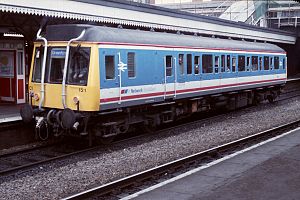British Rail Class 121
| British Rail Class 121 | |
|---|---|

Class 121 in Network South East livery at Paddington station – note the exhaust pipes and plated-over headcode box (1988)
|
|
| In service | 1960–present |
| Manufacturer | Pressed Steel Company |
| Order no. |
|
| Entered service | 1960 |
| Number built |
|
| Number preserved | 5 motor, 2 trailer |
| Formation |
|
| Diagram |
|
| Fleet numbers |
|
| Capacity |
|
| Operator(s) | |
| Depot(s) | |
| Line(s) served | Princes Risborough to Aylesbury Line |
| Specifications | |
| Car body construction | Steel |
| Car length | 64 ft 6 in (19,660 mm) (over body) |
| Width | 9 ft 0 in (2,740 mm) (over body) |
| Height | 12 ft 4 1⁄2 in (3,772 mm) |
| Doors | Slam |
| Articulated sections | Single car (2) |
| Wheelbase |
|
| Maximum speed | 70 mph (110 km/h) |
| Weight |
|
| Prime mover(s) |
|
| Cylinder count | 6 (horizontal) |
| Power output | 300 hp (220 kW) (DMBS) |
| Transmission | Mechanical (DMBS) |
| Train heating | Oil burning air heater |
| Bogies |
|
| Braking system(s) | Vacuum |
| Safety system(s) | AWS (DMBS) |
| Coupling system | Screw |
| Multiple working | ■ Blue Square |
| Headlight type | Fluorescent and tungsten |
| Track gauge | 4 ft 8 1⁄2 in (1,435 mm) |
Sixteen Class 121 single-car, double-ended driving motor vehicles were built from 1960, numbered 55020–55035. These were supplemented by ten single-ended trailer vehicles, numbered 56280–56289 (later renumbered 54280–54289). They have a top speed of 70 mph, with slam-doors, and vacuum brakes. The driving motor vehicles were nicknamed "Bubble cars" by some enthusiasts (a nickname now endorsed by current operator Chiltern Railways).
The Class 121 is Britain's longest serving DMU, having been in service for 57 years as of 2017.
The Class 121 were built for use on the Western Region of British Rail. They were used on various lightly used branch lines, including the Looe branch line (and various other branch lines) in Cornwall, the branch lines off the main line in the Thames Valley, the Bridport branch line (closed 1975), the Severn Beach line in Bristol and the Greenford Branch Line in West London.
Unlike the earlier (but similar) Class 122, which had a small destination indicator in the roof dome, Class 121 had a four-character headcode box in the roof dome, with the destination indicator inside the top of the centre cab window.
Upon privatisation of Britain's railways, the Class 121 fleet was only operated by one passenger company, namely Silverlink, with several more units in departmental duties with Railtrack. There are three examples left in revenue-making service.
In 2003, Chiltern Railways reintroduced "Heritage" diesel multiple units on its Aylesbury to Princes Risborough shuttle service. For this purpose, unit 121 020 (vehicle 55020) was purchased from Network Rail, and heavily refurbished to allow it to operate passenger services. It was repainted into Chiltern Railways blue livery. The introduction of this unit allowed the release of a Class 165 "Network Turbo" unit. This unit has been fitted with secondary (magnetic) door locking and other safety features, and thus was exempt from 30 November 2005 deadline for the withdrawal of all Mark 1 vehicles. Electronic destination indicators and internal passenger information systems were recovered from "Network Turbo" 165 032 at refurbishment and fitted to this unit. The external exhaust pipes were rerouted through the brake van area.
...
Wikipedia
